STORY BY DANIEL SAENZ
PHOTO COURTESY OF TRIBUNE NEWS SERVICE
On March 15, 2019, New Zealand experienced what Prime Minister Jacinda Ardern called one of the country’s “darkest days” in which a terrorist attack claimed over 50 lives. At two different mosques in the city of Christchurch, 28-year old Brenton Tarrant live-streamed himself as he stormed into and opened fire on the Al Noor Mosque, killing 42, and Linwood Mosque, killing seven. To add insult to injury, the perpetrator chose Friday, a holy day for Muslims, to commit the heinous deed. At the scene of the crime, the police found and subsequently disarmed two explosives attached to a vehicle.
So what would make someone commit such an act? A good clue that could help solve the puzzle is a manifesto that he left behind on social media shortly before the shooting spree occurred. In the document, Tarrant displays far-right and white nationalist beliefs.
Muslims, however, were the main target of his ire as he believed them to be invaders who would eventually replace white people. Also within the manifesto, he praised far-right murderers like Dylan Roof, who shot up a black church in South Carolina, and Anders Brevik, a far-right mass shooter based in Norway. According to him, his overall aim was to create an “atmosphere of fear” and “incite violence” against Muslims.
Despite the fact that this happened over a month ago, these racist tropes about practitioners of Islam is an ongoing issue that has been prevalent since the terrorist attacks on 9/11. The media has had a problem with focusing on sensationalizing news stories, and in particular, the media has sensationalized radical Islamic terrorism.
Dr. Ginger Loggins, a professor of journalism at Fort Hays State University, weighed in on the phenomenon. For her, it is a big issue with how the media talks about terrorism.
“Hate attacks like this, or attacks like bombing of an abortion clinic in Alabama, or the church shooting in South Carolina are often attributed to individuals who are working alone and they are usually not declared terrorist attacks,” Loggins said. “So the word terrorist is essentially something that a brown person does and not something that a white person does.”
Another issue is with how the media reports on the religion of Islam itself.
“There is an issue of everyone who follows Mohammed being the same and not recognizing the differences within the Muslim faith as they do within the Christian faith,” she added.
The media often portrays this grandiose class of civilizations with Muslims being one monolithic group that is hell-bent on destroying us. The way the media frames it is that Muslims are all the same and there are Islamic terrorists. Therefore, Muslims are terrorists according to the media’s narrative. And easily the worst offenders are media outlets such as Fox News and Breitbart that are almost blatantly trying to sew division with this tactic.
Elected officials are also guilty. During his campaign trail, President Trump promised to implement a ban on Muslims entering the United States and recently just took Representative Ilhan Omar’s words about 9/11 out of context to make her appear to be a un-American terrorist sympathizer.
What can we do to curve the casual bigotry espoused against Muslims by both public officials and the media? Dr. Loggins concludes by saying reporters need to hold themselves accountable.
“I think reporters need to continue checking themselves and need to consider exactly what their language is,” she said. “They need to be more aware of when they are using words that are imprecise and loaded terms.”
In short, the media needs to learn to make the distinction between individual actions and the groups that have nothing to do with the act.

